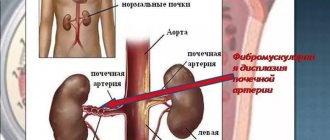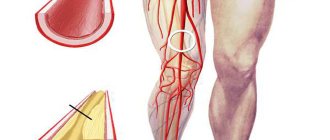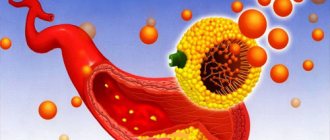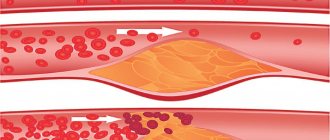© Author: A. Olesya Valerievna, candidate of medical sciences, practicing physician, teacher at a medical university, especially for SosudInfo.ru (about the authors)
Atherosclerosis of the BCA (brachiocephalic arteries) is one of the most common localizations of the atherosclerotic process, detected mainly in elderly and senile people and leading to hemodynamic disorders in the brain.
atherosclerotic deposits in the brachiocephalic arteries
Damage to blood vessels by atherosclerotic plaques is widespread among the world's population. This insidious disease begins gradually, even in adulthood, when a person leads an active lifestyle, works a lot and does not pay enough attention to his health due to lack of free time, still feeling good and lack of thoughts about approaching old age with its consequences.
Meanwhile, the initial signs of atherosclerosis can be detected already at the age of 40-45 years, more often in men. Women during this period are protected from atherosclerosis by sex hormones, but as menopause sets in and their concentrations decrease, the risk of pathology increases, and by the age of 65-70, the incidence of atherosclerosis, including the brachiocephalic arteries, becomes approximately the same in both sexes.
Atherosclerosis of the brachiocephalic arteries acquires particular significance due to impaired blood supply to the brain and the risk of the most dangerous condition - stroke, although the chronic manifestation of the pathology in the form of the development of dementia also causes a lot of trouble and sooner or later leads to the death of the patient.
The brachiocephalic arteries include the brachiocephalic trunk, left subclavian and common carotid arteries. These large trunks originate directly from the aorta and branch into vessels of smaller diameter that participate in the formation of the arterial (Circle of Willis) circle of the brain, which supplies blood to the nervous tissue.
The vertebrates begin from the subclavian arteries, which at the base of the brain merge into the basilar artery, a large artery that gives rise to the sources of blood supply to the posterior part of the cerebrum and cerebellum (posterior cerebral). The pathology of the vertebral arteries is known to many; most often it is their asymmetry or local narrowings that are congenital in nature, and atherosclerosis acquired during life greatly aggravates the lack of blood flow and contributes to cerebral ischemia.
The structure of the BCA and the cerebral arteries that feed from them
In order not to miss the onset of the disease, people at risk need to carefully monitor their well-being and regularly visit a doctor, undergo appropriate tests and take medications prescribed by a specialist. Timely diagnosis and treatment can slow the progression of atherosclerosis and prevent complications, the most dangerous of which is stroke.
BCA atherosclerosis: what is it?
The brachiocephalic arteries are a collection of vessels that supply the brain. They form the so-called Circle of Willis, which is responsible for uniform nutrition of absolutely all parts of the brain. The appearance of any narrowing of the lumen in any area of this circle can threaten oxygen starvation of the entire brain, and, in addition, the occurrence of a massive stroke.
The diagnostic age interval when most patients had ICD 10 cerebral atherosclerosis was 40-50 years.
Today, doctors distinguish two types of this atherosclerosis. What is it - non-stenotic atherosclerosis of the BCA? Against this background, fatty plaques are located longitudinally, without completely clogging the vessels. The second type is stenosing atherosclerosis of the BCA. With it, plaques form in the form of tubercles, they increase in size and are able to completely block the lumen of the vessel.
Of course, the second type of disease is the most dangerous. In the presence of such a deviation, untimely treatment inevitably leads to the development of a stroke. Non-stenotic atherosclerosis of the extracranial parts of the brachycephalic arteries is determined if the plaque covers less than half of the internal lumen. This disease requires timely treatment along with emergency medical care. In order to see a doctor in time, everyone should have an idea of the first symptoms of this pathology.
Everyone should know about this: symptoms of the disease
BCA atherosclerosis: what is it in terms of manifestation? Unfortunately, in its first stages, this disease does not have any clear symptoms that can prompt a person to immediately visit a doctor. As a rule, the very initial signs of BCA atherosclerosis can begin with the appearance of rare and short-term dizziness, which is attributed to other ailments or simple fatigue. But as time goes on, the head begins to feel dizzy more often, and a person may experience the following symptoms of atherosclerosis:
- Loss of concentration or decrease in concentration.
- Memory deteriorates.
- Feeling of pre-fainting.
- Fingers go numb.
- The appearance of tinnitus.
- Regular pressure surges.
- A condition accompanied by chronic fatigue.
The greatest danger is the process of stenosis in atherosclerosis of the BCA (narrowing of the arteries). With the development of this form of atherosclerosis, the following symptoms usually occur:
- There is a feeling of pain in the area of the heart.
- There is a stabbing sensation in the hands.
- The heart rhythm is disturbed.
- Vision deteriorates.
- Speech deteriorates.
- Nausea occurs.
- Dizziness appears.
What should you know about atherosclerosis of the brachiocephalic vessels?
Knowledge about the symptoms, as well as methods of treatment for atherosclerosis of the brachiocephalic arteries, is required by absolutely every person, and this is due to several reasons, namely:
- First of all, it should be noted that today atherosclerosis is generally one of the most common diseases, which, as a rule, doctors diagnose in every fifth person under the age of thirty, and in every fourth of five people of retirement age. Non-stenotic atherosclerosis of the extracranial parts of the BCA is being diagnosed more and more often.
- The described disease is included in the top three in terms of its prevalence among other atherosclerotic diseases.
- The severity, as well as the danger of the consequences, is due to the fact that with this pathology the arteries that supply the human brain with blood are damaged. The acute as well as chronic nature of cerebrovascular accidents develops extremely quickly.
Development mechanism
The brain receives nutrition through the brachiocephalic arteries, consisting of the carotid and vertebral arteries. At the base of the skull, these vessels form a vicious circle, so blood can spread evenly throughout the brain. Initially, fatty spots form inside the vessel, swelling appears and degeneration begins. As a result, fibrous tissue grows in the area of deposit concentration, which becomes the basis for the formation of a plaque. Calcium then accumulates in the lesion, causing the plaque to calcify.
Which patients are at risk?
So what is it - atherosclerosis of the BCA with the process of stenosis?
It predominantly develops among people who are already over forty. At the moment, doctors cannot name the exact cause of the formation of this pathology, but they identify several risk factors that contribute to the formation of the disease, namely:
- Smoking. This well-known bad habit causes a negative effect on the entire body as a whole, especially on the blood vessels. Due to smoking, the walls of blood vessels become extremely brittle, and, in addition, attacks of hypertension may occur. Smoking causes blood vessels to narrow, and due to certain factors, atherosclerosis can occur.
- High cholesterol. It is the high level of cholesterol that serves as the basis for atherosclerotic plaques. Harmful fat remains on the walls of blood vessels, and, in addition, arteries, which is why the lumen gradually narrows. For this reason, blood circulation is severely impaired and the risk of dangerous complications increases.
- Hypertension. With this disease, atherosclerosis often appears, but without stenosis. Then the disease progresses, various damage to the blood vessels occurs, which leads to their excessive fragility, as well as loss of elasticity.
- Hormonal imbalances, including while taking contraceptives.
- Sedentary lifestyle.
- Any concomitant pathologies.
- Genetic predisposition of the body.
Atherosclerosis of BCA and danger
Atherosclerosis of the extracranial parts of the BCA is considered an extremely dangerous disease, which without professional treatment can cause disability or death. Blockage of blood vessels leads to constant oxygen starvation of the brain. This subsequently leads to the development of a stroke. The main danger of pathology is late diagnosis. Atherosclerosis of the BCA (according to ICD 10 I70) is severe.
Despite the fact that today modern medicine is able to offer effective methods for the early diagnosis of atherosclerosis of BCA, people are in no hurry to consult a doctor when the first signs of the disease appear. Most often, patients turn to a specialist only when the disease has already begun to progress, significantly reducing the quality of life of a person.
Today, doctors unanimously declare that if any dizziness occurs, you should definitely undergo an examination. Of course, the head can feel dizzy for a variety of reasons, but timely detected pathology can be easily treated without any surgical intervention. People who suffer from pressure surges and other abnormalities in the functioning of the vascular system need to be examined at least once a year.
Diagnosis of atherosclerosis
If there are signs of atherosclerosis of the brachiocephalic arteries, a person is usually prescribed a number of different diagnostic procedures, through which doctors can assess the stage, and, in addition, the severity of the existing pathology. First of all, for these purposes, ultrasound examination of the relevant arteries is performed. In addition, patients are prescribed Doppler examination of blood vessels.
Such methods make it possible to assess the degree of narrowing of the lumen, the size of plaques, and the speed of blood flow. Establishing an assessment of these indicators allows specialists to select the optimal treatment for each patient individually.
Diagnostics
Effective treatment of the disease is impossible without a thorough diagnostic examination of the patient.
The main goals of diagnosis are:
- Determining the location of lipoid accumulations inside the artery, assessing their size and the degree of narrowing of the blood flow
- Assessment of the condition of vessel walls
- Determining the presence of blood clots
The examination is carried out by a trained specialist in an equipped medical facility. Based on the diagnostic results, the picture of the development of the pathology becomes clear to the doctor, and the doctor can develop the correct method of providing medical care.
Treatment of the disease
What is it - atherosclerosis of the BCA? Treatment, symptoms, and lifestyle for this disease depend on the degree of development of the disease. For example, if the disease has just begun to develop, and in addition to infrequent dizziness, a person does not have any other abnormalities, then drug treatment is quite possible. Such therapy is usually based on vasodilation, as well as on preventing the formation of cholesterol plaques.
In those situations in which the pathology has already begun to progress and stenosing atherosclerosis of the arteries is observed, then, most likely, the person will be prescribed surgical treatment in order to free up the lumens of the vessels. This operation is carried out using several methods, ranging from removing the clogged area to installing a stand in the problem area. Thus, the main stages in the treatment of atherosclerosis BCA today are:
- Complete cessation of any bad habits.
- Strict abstinence from eating fatty foods.
- Reasonable and regular physical activity.
- Fighting excess weight and reducing it.
- Treatment of concomitant pathologies.
- Reducing cholesterol levels through the use of medications.
- Preventive measures against blood clots.
- Use of vasodilators.
- A course of vitamins.
- If necessary, surgical intervention is required.
Prevention
Prevention of the disease should be comprehensive and include the following measures:
- change your diet;
- quit bad habits;
- maintain water balance;
- get enough sleep;
- to live an active lifestyle;
- avoid stressful situations;
- lose weight;
- exercise;
- undergo sanatorium-resort treatment;
- take regular walks in the fresh air.
Preventive measures should be accompanied by regular visits to the doctor and examinations.
Treatment of atherosclerosis with traditional methods
Atherosclerosis of the brachiocephalic vessels must be treated exclusively under the supervision of a physician. Self-medication of this pathology can lead to the most irreversible consequences. Traditional medicine, in turn, can offer a number of effective recipes, but they are advisable only as preventative agents or for use as part of complex treatment. Advanced forms of BCA atherosclerosis are simply impossible to eliminate in the absence of drug intervention. So, let's look at the most effective natural techniques against atherosclerosis:
- Garlic cloves. This product can be eaten either fresh or in the form of various tinctures. An excellent preventative recipe is a mixture of honey with lemon and garlic. Garlic strengthens blood vessels very well and makes their walls elastic and strong, and honey and lemon, in turn, replenish the lack of vitamins, helping to restore the vascular wall. But the most important thing to remember when treating with garlic is the regularity of its use.
- Rose hip. This product should be consumed in the form of an alcohol tincture or tea. The presented natural remedy is the most effective in preventing this disease. In addition, with the help of rose hips, primary atherosclerosis can be treated.
Dried alfalfa. This product has shown the greatest effectiveness in reducing cholesterol. The herb is usually brewed as tea or special alcoholic tinctures are prepared from it. As part of treatment with alfalfa, it is necessary to adhere to the dosage, as well as the dosage schedule.
It is important to note that in the presence of atherosclerosis of the brachiocephalic arteries, treatment should be prescribed exclusively by the attending physician, even if we are talking about traditional methods.
Diagnostic methods
An informative diagnostic method is vascular ultrasound, which is used to determine disturbances in blood flow.
A cardiologist can determine the pathology. An ultrasound procedure is performed, the echographic signs of which make it possible to identify pathology. These symptoms include:
- disturbance of blood flow speed;
- formation of plaques and blood clots;
- narrowing of the vessel cavity;
- bulges like an aneurysm.
If echo signs are present at the extracranial level, additional diagnostic methods are performed, such as:
- echo-CG;
- encephalography;
- angiography;
- aortography;
- X-ray of the aorta using a contrast agent;
- pulsometry;
- blood test for cholesterol.
Which doctors should I contact?
When the first signs of atherosclerosis occur, patients usually need to consult a neurologist. This specialist will make a differential diagnosis, and if the suspicions are confirmed, he will refer the patient to a cardiologist who specializes in the treatment of vascular pathologies.
The further treatment strategy will directly depend on the severity of the symptoms of the disease and on the results of instrumental and, in addition, laboratory tests.
Methods and techniques of preventive treatment
It hardly needs mentioning once again that atherosclerosis of the BCA vessels is an extremely dangerous disease, which is best prevented than treated. This type of pathology is more common today, and therefore doctors urge patients to take the best preventive measures, which include a healthy lifestyle along with proper nutrition. But it is important to consider that prevention should not be only temporary, but be part of the life of absolutely every person. Ideally, a culture of a healthy lifestyle should be instilled by parents from childhood. Only in this case will it be possible to protect yourself from the formation of most serious and dangerous diseases.
Every person should remember what it is - atherosclerosis of the BCA, that in its first stages it can be completely asymptomatic. If a person is at risk, then he should definitely take care of his health. Preventive measures and regular examinations should become part of the life of all patients who are at risk. At least once a year, such patients are required to undergo medical examination, monitoring the level of sugar, and, in addition, cholesterol in the blood. If any symptoms associated with vascular dysfunction occur, you should definitely contact your doctor.
Preventive actions
If there is a tendency to develop atherosclerosis of the BCA, it is necessary to regularly record ECHO signs of the disease, without missing scheduled medical examinations with a doctor. In addition, it is important to monitor your general health, respond to pathological symptoms in a timely manner, not engage in self-medication, give up bad habits forever, improve your diet, lose excess weight, and engage in physical activity. By following these simple preventive rules, it will be possible to prevent the progression of dangerous vascular pathology, as well as prevent complications associated with it.











